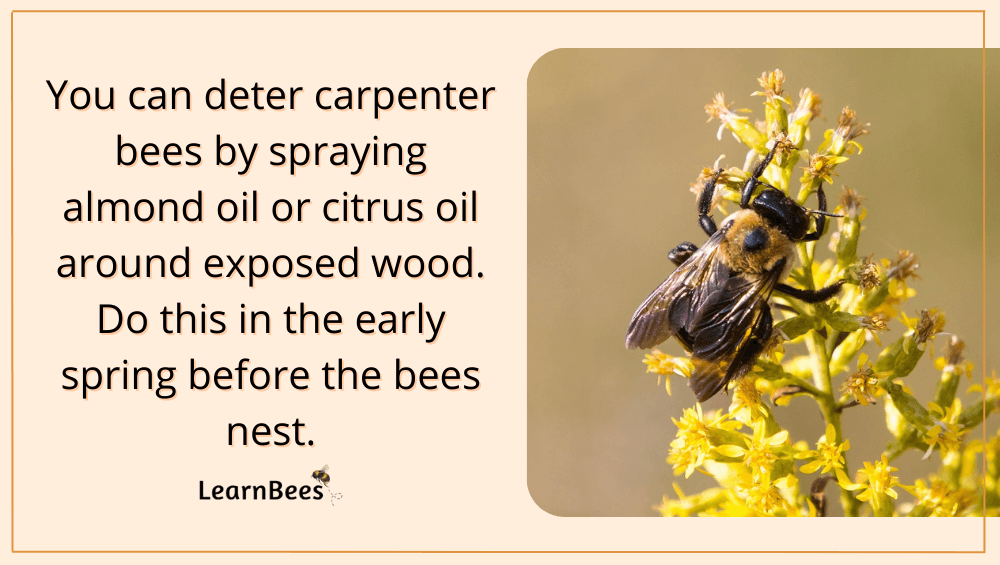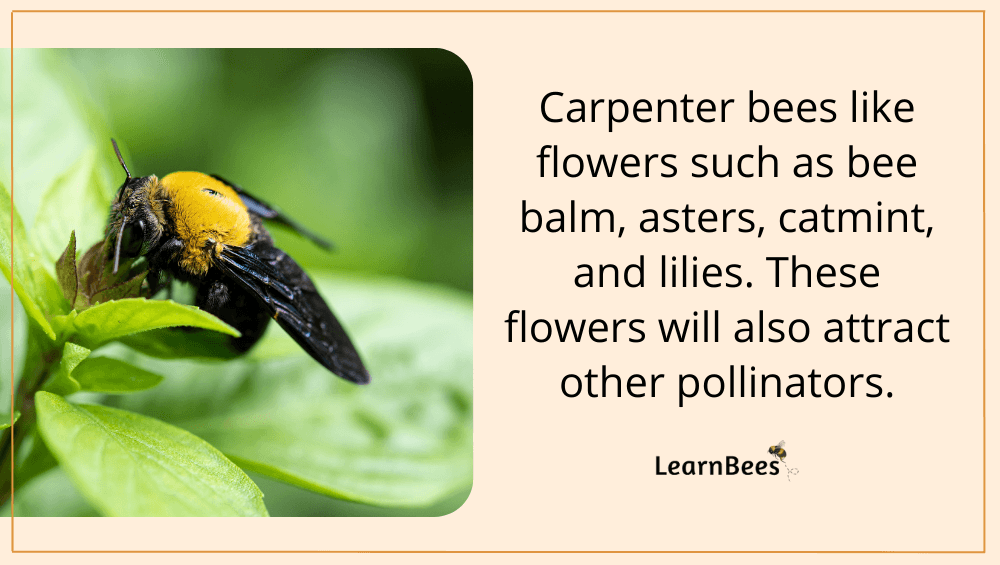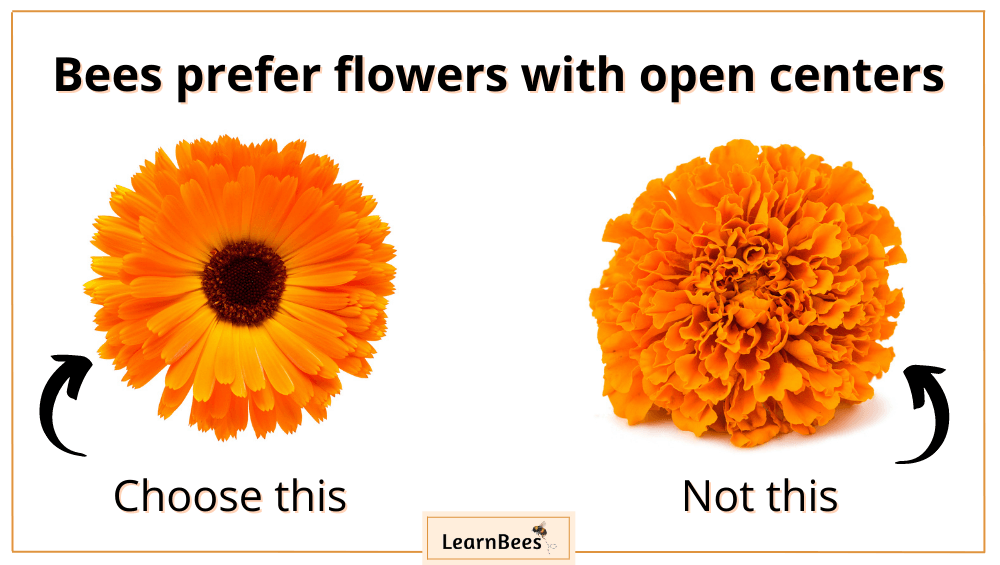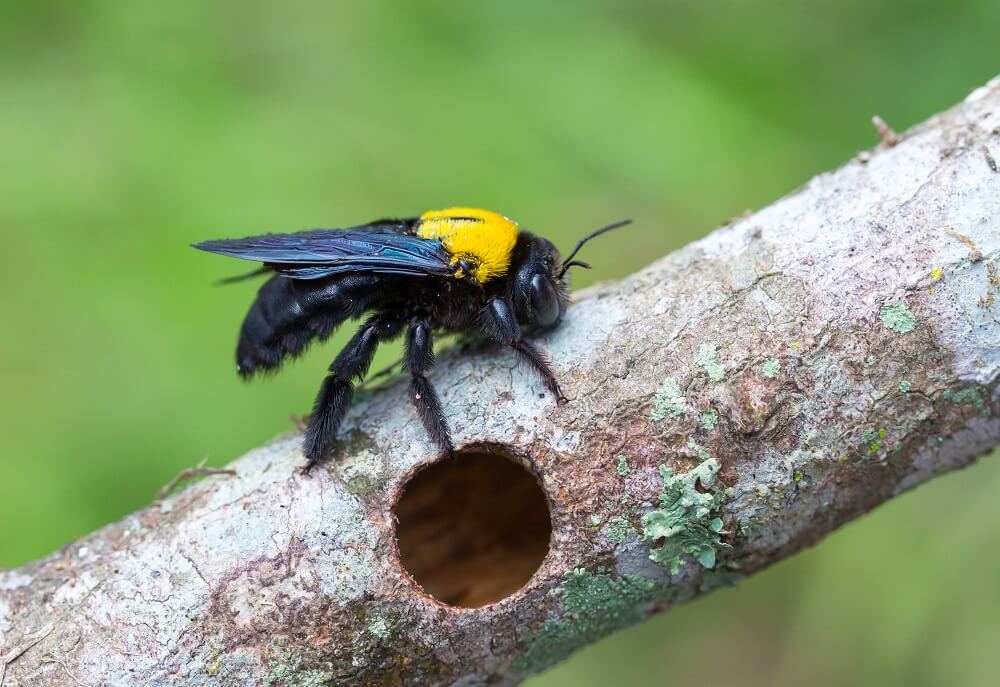Table of Contents:
What Do Carpenter Bees Eat?

Like other bees, carpenter bees eat the pollen and nectar they collect from flowers. Pollen is their protein source, while nectar is their carbohydrate source.
More specifically:
Carpenter bees love flowers like zinnias, salvia, oregano, and daylilies.
They help pollinate plants like these, allowing them to thrive and produce more seeds. This is why every gardener gladly welcomes essential pollinators like carpenter bees, bumblebees, and mason bees.
And what do carpenter bees drink?
Simple.
They drink water just like we do. Part of their water source comes from the morning dew they collect from flowers. Other sources include water from damp rocks, small puddles, and pond edges.
But I’ll shoot straight with you.
There are a lot of misconceptions about carpenter bees.
And one of the biggest misconceptions is that they eat wood. That’s not true. Carpenter bees don’t eat the wood, instead, they drill in it to build their nests and lay eggs.

Now you might be asking:
How do I keep carpenter bees away from my wood?
The best way to repel carpenter bees is to spray almond oil or citrus oil around exposed wood. They dislike the scent of these oils, so spray your wood liberally in the early spring before they start nesting.
And here’s the important part:
Almond oil or citrus oil won’t hurt the carpenter bees. This is crucial because they’re valuable pollinators of the food we eat. Not to mention, carpenter bees are known as ‘gentle giants’ because of their large size and calm demeanor.
And surprisingly enough?
Only female carpenter bees can sting. Male carpenter bees cannot.
That said, it’s unlikely that you’ll come into contact with a female since she’s busy nesting and laying eggs.
As a result:
Male carpenter bees are the ones you have the most contact with. Despite not having stingers, the males still protect their nests. They do so by buzzing around potential intruders until it scares them off.
But don’t worry.
Male carpenter bees are all talk and no action.
What Flowers Do Carpenter Bees Like?

Like all bees, carpenter bees need pollen and nectar to survive.
And the good news?
Helping carpenter bees helps other pollinators too. Your local bumblebees, hummingbirds, and butterflies will all reap the benefits of a pollinator-friendly garden.
So what can you do?
Start by planting flowers that are rich sources of pollen and nectar. Carpenter bees love plants like:
But remember:
Not all plants are created equally. For instance, carpenter bees like flowers with open centers that are easy to access. Flowers with multiple layers of petals make accessing pollen and nectar hard.

Take me, for example.
Pollinators love my garden. I can sit on my porch and watch numerous bees, butterflies, and hummingbirds enjoy my flowers.
If you’re new to gardening, I recommend starting with container gardening.
Container gardening is when plants are grown in pots instead of the ground. This will allow you to easily try out different flowers to see what the bees are drawn to.
A few other pros of container gardening include:
- The ability to move them around (including indoors during harsh weather)
- You can easily give your plants better soil quality
- Container gardens can offer a “neater” look
- You’ll spend much less time weeding
Container gardens tend to dry out quicker than plants in the ground, so water them thoroughly.
And if you want a bigger bang for your buck:
Use a plant food like this one to grow larger and more vibrant flowers. I just mix it with my watering can, and it does the job.
FAQs on “What Do Carpenter Bees Eat?”
- Do carpenter bees eat sugar water?
- Do carpenter bees eat honey?
- Does a carpenter bee eat wood?
- How long can carpenter bees live without food?
- Do carpenter bees eat ants?
- What is a carpenter bee’s favorite food?
- Do carpenter bees eat cedar?
- Can carpenter bees eat through caulk?
- Do carpenter bees eat fruit?
- What kind of wood do carpenter bees like?
Do carpenter bees eat sugar water?
Yes, carpenter bees will sometimes eat sugar water if nectar sources are low in your area. This means you may see carpenter bees at your hummingbird feeders.
That said, bees don’t just drink sugar water for the sake of it. They only do so during periods of nectar dearth, such as when flowers wilt due to high summer temperatures.
Some people mistakenly claim that bees rely on sugar water because it’s convenient and the bees are lazy. This simply isn’t true. If there are enough nectar sources in your area, the carpenter bees won’t touch the sugar water. They’ll only drink it when food is scarce.
But don’t worry.
Bees coexist peacefully with other pollinators, such as hummingbirds and butterflies. It’s not uncommon to see bees and hummingbirds drinking from the same feeder.
—> Go back to the FAQs on “What Do Carpenter Bees Eat?”
More to Explore:
Do carpenter bees eat honey?
No. Unlike honeybees, carpenter bees don’t make nor eat honey.
This is because carpenter bees are solitary bees that aren’t active during the winter. On the other hand, honeybees are social bees that live in large colonies. Honeybees also overwinter and rely on their honey storage as food during the cold months.
Also, honeybees have thousands of colony members to help them produce honey. Since most carpenter bee species are solitary, they simply don’t have the extra hands to make honey.
So instead of eating honey?
Carpenter bees get their food sources strictly from pollen and nectar.
Keep in mind:
Never try to feed carpenter bees or other bees honey. Bees can only eat honey from their own hives. Giving bees honey from the grocery store or other hives can introduce bacteria to them from other beehives.
—> Go back to the FAQs on “What Do Carpenter Bees Eat?”
More to Explore:
Does a carpenter bee eat wood?
People often ask, “Why do carpenter bees eat wood?”
This is a common misconception surrounding carpenter bees. Carpenter bees don’t eat wood like termites do.
Carpenter bees drill into wood to lay their eggs and raise their young. The tunnels they create are called burrows. These burrows are usually perfect circles about 1/2 inch in diameter.
Depending on the species, carpenter bees may create their burrows in different types of wood. For example, carpenter bees prefer untreated softwoods such as cedar, redwood, pine, and cypress.
Painted or pressure-treated wood helps deter them.
—> Go back to the FAQs on “What Do Carpenter Bees Eat?”
More to Explore:
How long can carpenter bees live without food?
Bees can’t live long without access to food or water. If a bee is trapped indoors, it’ll live no more than 24 hours.
—> Go back to the FAQs on “What Do Carpenter Bees Eat?”
More to Explore:
Do carpenter bees eat ants?
People regularly ask:
Do carpenter bees eat wasps? Do carpenter bees eat bees? Do carpenter bees eat mosquitos? Do carpenter bees eat each other? Do carpenter bees eat bugs?
The answer is that carpenter bees only eat pollen and nectar from flowers. The types of flowers carpenter bees are attracted to include salvia, lilies, zinnias, and bee balm.
Like most other types of bees, carpenter bees are peaceful creatures that get along well with other pollinators. You don’t have to worry about bees attacking hummingbirds or butterflies. Instead, they can safely drink nectar from flowers while sitting next to each other.
In short:
Carpenter bees don’t eat bugs like wasps do. They rely on nectar for carbohydrates and pollen for protein. So if you see a carpenter bee chasing off a bug, it’s usually because they’re protecting their nest from intruders. It’s not because they’re trying to eat them.
—> Go back to the FAQs on “What Do Carpenter Bees Eat?”
More to Explore:
What is a carpenter bees favorite food? What attracts carpenter bees?
“What can I feed a carpenter bee?” and “What do carpenter bees eat and drink?” are common questions we get.
If you want to attract native bees like carpenter bees, bumblebees, and mason bees to your yard, start by planting flowers they love. Thankfully, the internet is a wonderful resource for finding plants rich in both nectar and pollen.
That said, different bees are attracted to certain flowers. For example, carpenter bees like zinnias, bee balm, and asters. Bumblebees love hostas, foxgloves, and lavender.
This is because some species of bees have longer tongues than others. For instance, certain species of bumblebees have longer tongues, so they can reach into tubular flowers easier than other bees can.
So the best way to feed carpenter bees is to offer various flowers such as:
- Catmint
- Salvia
- Bee Balm
- Asters
- Zinnias
- Lilies
Try to pick flowers that have long blooming periods throughout the year. This ensures your local carpenter bees will have plenty to choose from throughout the various seasons.
It’s especially important to plant flowers that bloom in early spring since this is when female carpenter bees come out of hibernation and need to replenish quickly. Also, it helps to plant drought-tolerant plants that can withstand the high summer temperatures.
—> Go back to the FAQs on “What Do Carpenter Bees Eat?”
More to Explore:
- Ground Bees: Are They a Threat to Your Yard?
- Wasps vs. Honeybees: Are They Different?
- Do Bumble Bees Bite?
Do carpenter bees eat cedar?
We get asked questions like this often, along with other questions like:
Do carpenter bees eat pine? Do carpenter bees eat redwood? Do carpenter bees eat cypress? Do carpenter bees eat pressure-treated wood? Do carpenter bees eat treated wood?
Here’s the thing:
Carpenter bees don’t actually eat wood. That’s a common myth associated with them. Instead, they eat nectar and pollen from blossoms. They’re active in the spring and summer and die off once the weather gets cooler.
So why do carpenter bees make holes in wood?
Because that’s where they nest. They use their strong jaws to drill into wood to build their homes. Their holes measure between 1/2 to 1 inch in diameter and a few inches deep.
Carpenter bees are the largest native bee in the United States, so their tunnels have to be large enough to hold them.
The female carpenter bee is responsible for drilling while male carpenter bees patrol outside the nest for intruders. They’re solitary bees, so they live alone instead of in large colonies.
—> Go back to the FAQs on “What Do Carpenter Bees Eat?”
More to Explore:
Can carpenter bees eat through caulk?
Carpenter bees can chew through caulk, but they’re unlikely to do so since they’re attracted to wood.
And remember:
Using caulk only seals old nests. It doesn’t prevent future carpenter bees from building new ones around the same spot. Still, it’s good to fill old carpenter bee tunnels with caulk during the late fall once the bees aren’t active.
This prevents them from coming back to the same hole next year.
Spray almond oil or citrus oil liberally along exposed wood to deter future carpenter bees. Carpenter bees dislike the scent of such oils, so it’ll repel them from nesting in that area. Just make sure to spray this repellant in early spring before they start nesting.
—> Go back to the FAQs on “What Do Carpenter Bees Eat?”
More to Explore:
- Do Carpenter Bees Pollinate?
- How Long Do Bumble Bees Live?
- Honeybees vs. Bumblebees: How Do They Compare?
Do carpenter bees eat fruit?
Carpenter bees will eat ripened fruit if nectar sources are low. For example, low rainfall or high summer temperatures can result in nectar dearths. During these times, carpenter bees may turn to ripened fruit or sugar water from hummingbird feeders for food.
Don’t be concerned if you see carpenter bees near your hummingbird feeders. Bees and other pollinators like hummingbirds and butterflies coexist peacefully together.
—> Go back to the FAQs on “What Do Carpenter Bees Eat?”
More to Explore:
What kind of wood do carpenter bees like?
Carpenter bees like unpainted, weather wood, particularly softwoods like cedar, redwood, cypress, and pine. Painted or pressure-treated wood is much less likely to be drilled into by carpenter bees.
Some of the most common nesting sites for carpenter bees include eaves, wood siding, decks, and fences.





